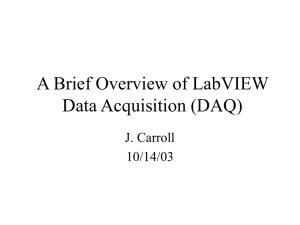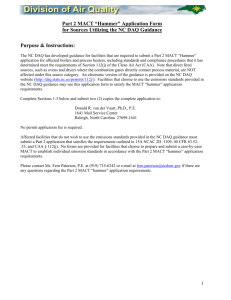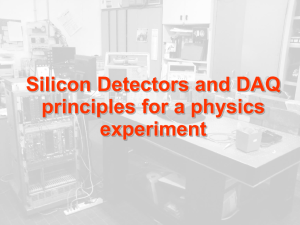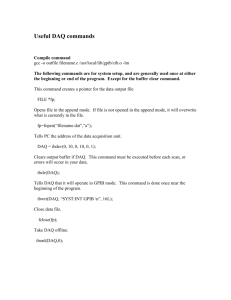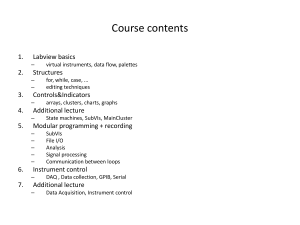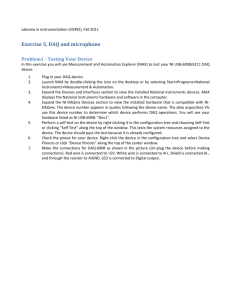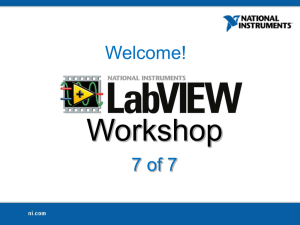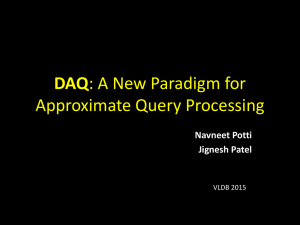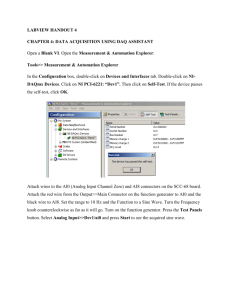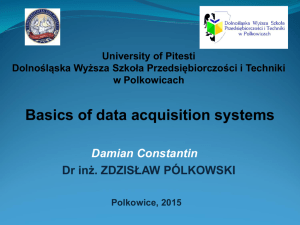VME based data acquisition system for ACCULINNA
advertisement
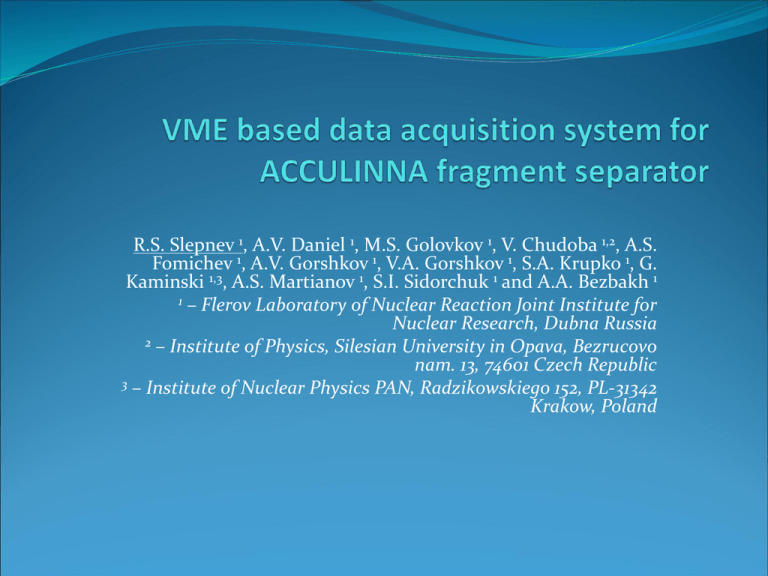
R.S. Slepnev 1, A.V. Daniel 1, M.S. Golovkov 1, V. Chudoba 1,2, A.S. Fomichev 1, A.V. Gorshkov 1, V.A. Gorshkov 1, S.A. Krupko 1, G. Kaminski 1,3, A.S. Martianov 1, S.I. Sidorchuk 1 and A.A. Bezbakh 1 1 – Flerov Laboratory of Nuclear Reaction Joint Institute for Nuclear Research, Dubna Russia 2 – Institute of Physics, Silesian University in Opava, Bezrucovo nam. 13, 74601 Czech Republic 3 – Institute of Nuclear Physics PAN, Radzikowskiego 152, PL-31342 Krakow, Poland Introduction In order to study light proton and neutron rich nuclei close to drip line, the physics programs for the ACCULINNA facility and the future ACCULINNA-2 facility require a relevant data acquisition system (DAQ). Such a system should satisfy several conditions: it should have low price per channel, ability to process a high trigger rate with a low ‘dead time’, and in addition it should be scalable and flexible. VME based data acquisition system Detectors Preamplifiers Amplifiers & Discriminators DAQ in this scheme includes various electronic modules, computers and the related software. To save time, we decided to take existing DAQ from GSI as the architectural prototype. The DAQ is based on VME and CAMAC modules, real time Operating System LynxOS and MBS software, combined with Go4 software based on ROOT data analysis framework for visualization of the information coming from the detectors. DAQ Software The screen with data output of Go4 software is shown. The top row reflects data from TOF plastics (two matrix of Left Amplitude vs. Right Amplitude and DE-TOF spectrum), the bottom row shows beam spot on the target in both directions (data from MWPC’s). In order to use MBS program and see information from VME and CAMAC modules one should have functions in C language for each type of module and write user function as main program where described procedure of initializing, readout, etc. Thereto the C code obtained should be compiled in LynxOS running on RIO-3 VME module that is booting by network from the external computer working on Scientific Linux. If everything were made right one can start the MBS program in LynxOS, which we generally used to read out VME and CAMAC modules. After that, data acquisition should be started from this program. To see the events coming from the detectors in graphics online, we used Go4 software. New possibilities Typical identification plot ‘Energy loss in 68 mkm silicon vs. TOF’ when ACCULINNA facility was tuned for the maximal yield of 18Ne nuclei (contamination of unwanted nuclei in the focal plane F4 was ~75%). 26S By this experiment it was shown, that thereby we can work now on the ACCULINNA facility with RIBs (generally proton rich) when in the beam there is only a very small percent of nuclei that we want to obtain and utilization of the detectors, electronics and DAQ is very large. In the future we are planning to use advantages of new DAQ by starting working with new VME modules – registers, digitizers, etc. In addition we can plug in to our DAQ the crates in other standards (Fastbus, VXI) which give us possibility to use for example detectors and electronics for registering discrete gamma rays. Since the data files from DAQ can be easily converted to ROOT format one can use this framework to analyze the experimental data. Thus, thereby we have got working DAQ that meets to modern experimental requirements in heavy ion physics. Conclusion We have studied and applied new data acquisition system. The existing software (Go4 v.4.4.3) was upgraded on 64 digit platform and several new user functions were developed (Mesytec MADC-32, CAEN V775NC). The performed work allows us to conduct some experiments on the world level by now those were unavailable earlier for us.
